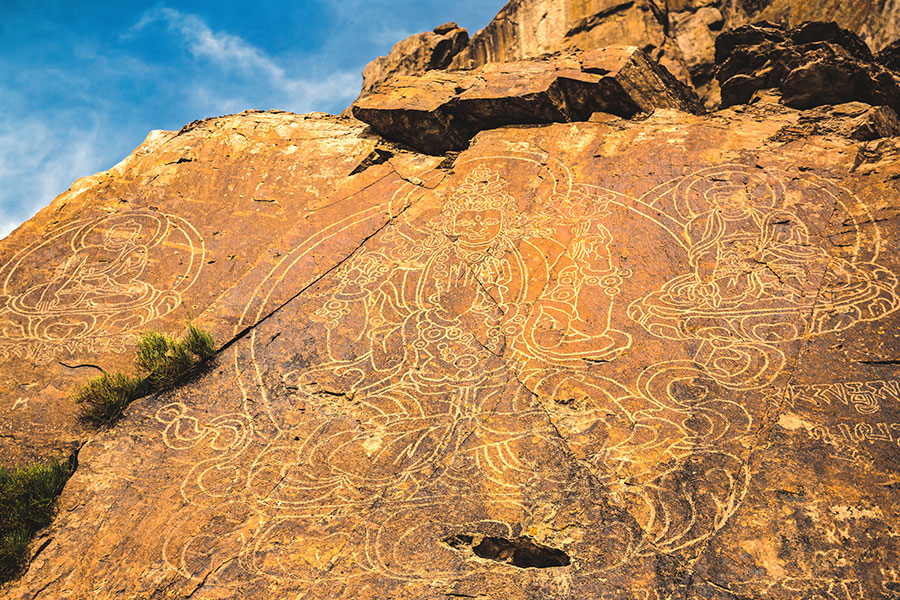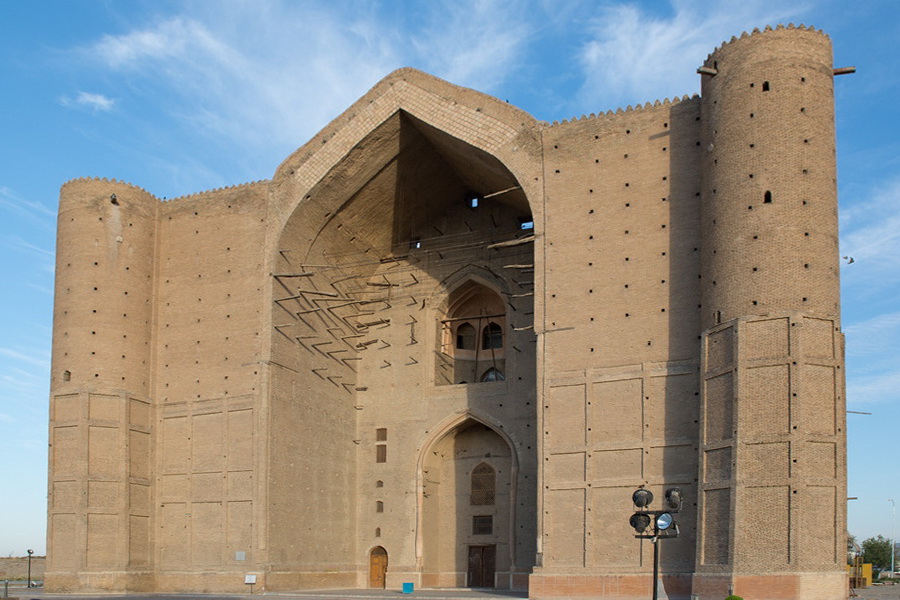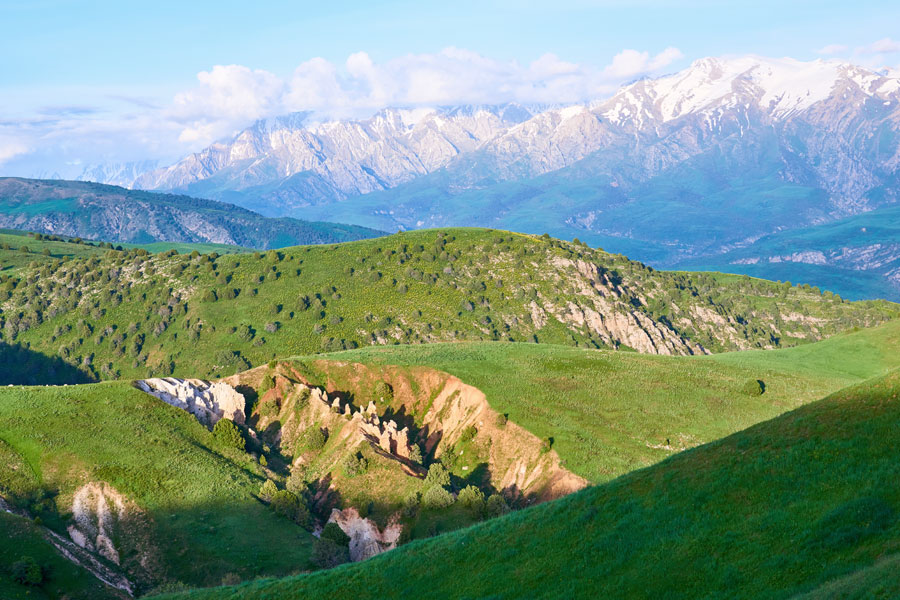
Kazakhstan and UNESCO
Kazakhstan joined UNESCO in 1992, and its first site was added to the UNESCO list in 2003: the renowned mausoleum of Khoja Ahmed Yasawi. The World Heritage List also features unique architectural and natural sites within Kazakhstan. Today, the country is home to more than 50 clubs, over 30 specialized schools, and 6 UNESCO Chairs.
Kazakhstan boasts six unique sites on the UNESCO World Heritage List:
- Mausoleum of Khoja Ahmed Yasawi (included in 2003),
- Petroglyphs of the Archaeological Landscape of Tanbaly (included in 2004),
- Saryarka – Steppe and Lakes of Northern Kazakhstan (included in 2008),
- Silk Roads: the Routes Network of Chang'an-Tianshan Corridor (included in 2014),
- Western Tien-Shan (included in 2016),
- Cold Winter Deserts of Turan (included in 2023).
Mausoleum of Khoja Ahmed Yasawi

The Mausoleum of Khoja Ahmed Yasawi was constructed in the Kazakh city of Turkestan, formerly known as Yassy. This tomb, built for the Sufi poet and follower of the Prophet Muhammad, dates back to the late 14th and early 15th centuries and was commissioned by Amir Timur himself. Although the building remains partially unfinished, it is a unique monument representing the cultural heritage of the Kazakh people.
The mausoleum showcases architectural experiments that were later applied in the Uzbek city of Samarkand. Comprised of 35 rooms, numerous vaults and domes, and adorned with Quranic inscriptions and wall paintings, the burnt brick structure is an architectural marvel. Notably, the dome above the main hall is considered the largest in Central Asia. The mausoleum complex also includes an underground mosque, an ancient bathhouse, and the mausoleum of Amir Timur's granddaughter, Rabia Sultan Begim. The Yassawi Mausoleum is recognized as a masterpiece of human creativity and represents an outstanding achievement in Timurid-era architecture, significantly influencing the evolution of Muslim architecture in Central Asia.
Petroglyphs of the Archaeological Landscape of Tanbaly
Discovered in the mid-20th century, the rock paintings in the Tanbaly Gorge in the Almaty region are located in the southeast of the Chu-Ili Mountains. These 5,000 petroglyphs, primarily from the second half of the 2nd millennium BC, are divided into seven groups based on location.
The drawings illustrate hunting scenes, warriors, animals, women giving birth, wedding couples, deities, and sacrificial rituals. Areas with a high concentration of petroglyphs suggest the presence of altars for prayers and sacrifices. Additionally, numerous ancient burials from the Middle and Late Bronze Age, along with the remains of dwellings, have been found near the petroglyphs. Interestingly, some of the drawings overlap, with newer images superimposed over older ones.
Saryarka – Steppe and Lakes of Northern Kazakhstan
This UNESCO site encompasses two vast areas within the Naurzum State Nature Reserve and the Korgalzhyn State Nature Reserve, both of which are home to rare and even endangered species. Kazakhstan is a crucial stopover point for migratory birds traveling from Europe, South Asia, and Africa to Siberia.
Additionally, UNESCO safeguards 200,000 hectares of the Central Asian steppe, which supports a diverse array of wildlife, including some rare species, and several lakes. Natural ecological and biological processes in these areas remain largely undisturbed.
Silk Roads: the Routes Network of Chang'an-Tianshan Corridor
This UNESCO World Heritage Site stretches 5,000 kilometers and spans three countries: Kazakhstan, Kyrgyzstan, and China. The corridor begins in the ancient and now-defunct city of Chang'an, which once served as the capital of several Chinese states, and ends in the Kazakh town of Zhetysu (Semirechye). This corridor operated from the 2nd to 1st centuries BC until the 16th century. In some sections, the route extended over 8,700 kilometers, with some parts even exceeding 30,000 kilometers.
The road connecting Kazakhstan and China facilitated not only trade but also the spread of religion, science, culture, and art. Along the Chang'an-Tian Shan Road, one can find ancient buildings and trails, Buddhist temples in caves, sections of the Great Wall of China, tombs, mountain passes, lakes, deserts, trading villages, caravanserais, and more.
The most notable Kazakh sites are located in the Almaty region, including Talgar, Karamergen, and Kayalyk, as well as the Zhambyl region, which features Akyrtas, Aktobe, Kostobe, Stepninskoye, Ornek, and Kulan. The routes display significant elevation changes, ranging from 154 meters below sea level to 7,400 meters above sea level.

Western Tien-Shan
The Western Tien Shan, a significant part of the globally renowned Tien Shan mountain system, spans across three countries: Kazakhstan, Kyrgyzstan, and Uzbekistan. The World Heritage List for Kazakhstan features three sites: the Karatau Reserve, the Aksu-Jabagly Reserve, and the Sairam-Ugam National Park.
Located in the Zhambyl region of Kazakhstan, the Aksu-Jabagly Reserve is the country's oldest protected area, established in 1926. The reserve is known for its diverse array of animal, bird, fish, and insect species, as well as its rich variety of flora. Ten mammal species found in the Aksu-Jabagly Reserve, such as the snow leopard, Menzbira marmot, and an endemic subspecies of argali, are included in the Red List.
The Karatau Reserve, covering over 34,000 hectares, is situated in the Turkestan Region. This reserve is home to the red-listed Karatau argali, stone marten, Indian porcupine, black and white storks, dwarf eagle, golden eagle, eagle owl, snake eagle, and other animal, bird, arthropod, and insect species. Additionally, more than 1,600 plant species thrive here.
Sairam-Ugam National Park, located in the Turkestan province, encompasses seven natural zones. The park hosts approximately 60 mammal species, nearly 300 bird species, and over 1,600 plant species, 240 of which are included in the Red List.
Turanian Deserts in the Temperate Region
The Turanian Deserts, recognized as a UNESCO World Heritage Site, span multiple nations, showcasing their transnational significance. These expansive deserts are under UNESCO protection in both Turkmenistan and Uzbekistan. On the Kazakh side, the World Heritage designation encompasses two notable areas: the Barsakelmes State Nature Reserve in Kyzylorda Oblast and the Altyn-Emel State National Nature Park in Almaty Oblast. This designation highlights the global importance of preserving these unique desert ecosystems.
- Turkic Sanctuary of Merke (included in 1998): Most such sites worldwide have suffered significant damage. However, the sanctuary in ancient Merke, situated at an elevation of 3,000 meters above sea level, has preserved ritual and burial mounds dating from the 6th to 14th centuries.
- Northern Tyan-Shan (Ile-Alatau State National Park) (added in 2002): Located in the Almaty region, this site holds particular significance for Kazakhstan. Ile-Alatau National Park is home to hundreds of animal species, including 13 endangered species listed in the Red Book. It also harbors 50% of Kazakhstan's entire fauna.
- Abylaikit Monastery (added in 2021): Constructed in the mid-17th century by the Zhungar ruler Abylai, this Buddhist monastery was named in his honor. Numerous manuscripts and remnants of birch bark texts detailing the history of the East Kazakhstan region have been preserved here.
- Cultural Landscape of Ulytau (added in 2021): The Ulytau mountains, situated in the Karaganda region, were inhabited as early as the mid-4th millennium BC. In the Middle Ages, rulers of the Golden Horde and descendants of Genghis Khan were buried here. Later, it served as a residence for Kazakh khans.
- Petroglyphs within the Archaeological Landscape of Arpauzen (added in 2021): This stunning natural and archaeological landscape features ancient settlements, burial stones, and 30 groups of petroglyphs. The oldest petroglyphs date back to the first half of the 2nd millennium BC.
- Petroglyphs within the Archaeological Landscape of Eshkiolmes (added in 2021): Located near Taldykorgan, these petroglyphs are part of an archaeological monument complex, which also includes ancient human settlements and burials. The Yoshkolmes Mountains' archaeological landscape contains more than 250 monuments, with the earliest belonging to the Bronze Age.
- Petroglyphs within the Archaeological Landscape of Kulzhabasy (added in 2021): Researchers suggest that the earliest drawings date back to the 3rd-2nd millennia BC. Additionally, they believe that the Kulzhabasa rock art predates the Tanbala petroglyphs, which were inscribed on the UNESCO World Heritage List in 2004.
- Petroglyphs within the Archaeological Landscape of Sauyskandyk (added in 2021): In the late 19th century, over 3,000 rock paintings were discovered in this area. Unlike other Kazakh archaeological landscapes featuring petroglyphs, Sauyskandyk is situated on the historical border between the nomadic peoples' steppes and sedentary oases.
- Rocky Mosques of Mangyshlak Peninsula (added in 2021): This complex encompasses the underground mosques of the Mangistau region: Shopan-ata, Karaman-ata, Sultan-Ele (patron saint of sailors), Shakpak-ata (lord of fire), and Beket-ata. Each mosque is named after a Sufi saint buried there.
- The Great Silk Road: Prehistoric Period (added in 2021): This period includes three necropolises: Boraldai, Besshatir, and Yesik. The most renowned necropolis is Yesik, also called Yesik Kurgan, where the famed "Golden Man" (the remains of a Sak warrior adorned in gold) was discovered.
- The Great Silk Road: Fergana-Syrdarya Corridor (added in 2021): This corridor encompasses ancient settlements such as Otrar (1st-19th centuries), Sygnak (1st-18th centuries), Zhankent (1st-18th centuries), Yassi-Turkestan (1st-14th centuries), Kyshkala (5th-17th centuries), Asanas (6th-15th centuries), and Zhankala (11th-14th centuries), as well as the Zhetasar Oasis site (1st millennium BC - early 9th century) and the Sauran archaeological complex (1st-18th centuries).
- The Great Silk Road: Volga-Caspian Corridor (added in 2021): The historical route from Kazakhstan features three ancient settlements: Kyzylkala (10th-13th centuries), Saraichik (13th-16th centuries), and Zaiyk (13th-15th centuries).
- Ustyurt: Natural Landscape and Aran Hunting Traps (added in 2021): Arans are ancient hunting traps situated along the cliffs of the western part of the Ustyurt plateau in the Mangistau region. Researchers believe that these traps have been in use since the Bronze Age.
Removed sites from the tentative UNESCO list:
- Begazy-Dandybayev Megalithic Mausoleums (added in 1998, removed due to updating the tentative list).
- Tasmolinsk Culture Mounds with Stone Circles (added in 1998, removed due to updating the tentative list).
- Paleolithic Sites and Geomorphology of the Karatau Ridge (added in 1998, removed due to updating the tentative list).
- Archaeological Sites of the Otrar Oasis (added in 1998, removed in 2021 due to the inclusion of "The Great Silk Road: Fergana-Syrdarya Corridor" in the tentative list).
- Altyn-Emel State National Park (added in 2002, removed in 2021 due to the addition of the Turan Temperate Desert Belt site to the tentative list).
- The Great Silk Road (added in 2012, removed in 2021 due to the division of the Great Silk Road corridor sites).
UNESCO World Heritage Sites in Kazakhstan foster intercultural and intercivilizational dialogue. Thousands of tourists from around the world visit sites such as the Mausoleum of Khoja Ahmed Yassawi, the Western Tien Shan, Sary-Arka, the Chang'an-Tien Shan Corridors, and the Tanbala petroglyphs.
Discover more about the intangible UNESCO World Heritage Sites in Kazakhstan.

